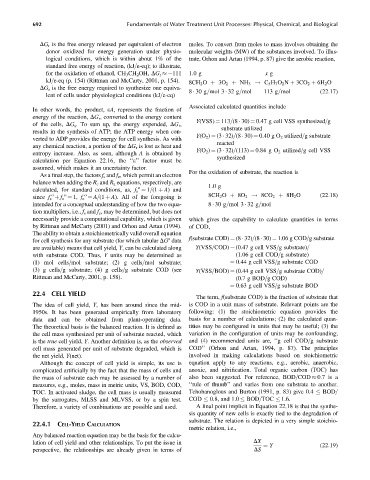Page 737 - Fundamentals of Water Treatment Unit Processes : Physical, Chemical, and Biological
P. 737
692 Fundamentals of Water Treatment Unit Processes: Physical, Chemical, and Biological
DG r is the free energy released per equivalent of electron moles. To convert from moles to mass involves obtaining the
donor oxidized for energy generation under physio- molecular weights (MW) of the substances involved. To illus-
logical conditions, which is within about 1% of the trate, Orhon and Artan (1994, p. 87) give the aerobic reaction,
standard free energy of reaction, (kJ=e-eq); to illustrate,
for the oxidation of ethanol, CH 3 CH 2 OH, DG r 111 1:0 g x g
kJ=e-eq (p. 154) (Rittman and McCarty, 2001, p. 154).
8CH 2 O þ 3O 2 þ NH 3 ! C 5 H 7 O 2 N þ 3CO 2 þ 6H 2 O
DG s is the free energy required to synthesize one equiva-
8 30 g=mol 3 32 g=mol 113 g=mol (22:17)
lent of cells under physiological conditions (kJ=e-eq)
Associated calculated quantities include
In other words, the product, eA, represents the fraction of
energy of the reaction, DG r , converted to the energy content
Y(VSS) ¼ 113=(8 30) ¼ 0.47 g cell VSS synthesized=g
of the cells, DG s . To sum up, the energy expended, DG r ,
substrate utilized
results in the synthesis of ATP; the ATP energy when con-
Y(O 2 ) ¼ (3 32)=(8 30) ¼ 0.40 g O 2 utilized=g substrate
verted to ADP provides the energy for cell synthesis. As with
reacted
any chemical reaction, a portion of the DG r is lost as heat and
Y(O 2 ) ¼ (3 32)=(113) ¼ 0.84 g O 2 utilized=g cell VSS
entropy increase. Also, as seen, although A is obtained by
synthesized
calculation per Equation 22.16, the ‘‘e’’ factor must be
assumed, which makes it an uncertainty factor.
For the oxidation of substrate, the reaction is
As a final step, the factors f s and f e , which permit an electron
balance when adding the R c and R a equations, respectively, are 1:0 g
o
calculated, for standard conditions, as, f s ¼ 1=(1 þ A) and
o
o
o
since f s þ f e ¼ 1, f e ¼ A=(1 þ A). All of the foregoing is 8CH 2 O þ 8O 2 ! 8CO 2 þ 8H 2 O (22:18)
intended for a conceptual understanding of how the two equa- 8 30 g=mol 3 32 g=mol
tion multipliers, i.e., f s and f e , may be determined, but does not
necessarily provide a computational capability, which is given which gives the capability to calculate quantities in terms
by Rittman and McCarty (2001) and Orhon and Artan (1994). of COD,
The ability to obtain a stoichiometrically valid overall equation
f(substrate COD) ¼ (8 32)=(8 30) ¼ 1.06 g COD=gsubstrate
for cell synthesis for any substrate (for which tabular DG8 data
are available) means that cell yield, Y, can be calculated along Y(VSS=COD) ¼ (0.47 g cell VSS=g substrate)=
with substrate COD. Thus, Y units may be determined as (1.06 g cell COD=g substrate)
(1) mol cells=mol substrate; (2) g cells=mol substrate; ¼ 0.44 g cell VSS=g substrate COD
(3) g cells=g substrate; (4) g cells=g substrate COD (see Y(VSS=BOD) ¼ (0.44 g cell VSS=g substrate COD)=
Rittman and McCarty, 2001, p. 158). (0.7 g BOD=g COD)
¼ 0.63 g cell VSS=g substrate BOD
22.4 CELL YIELD
The term, f(substrate COD) is the fraction of substrate that
The idea of cell yield, Y, has been around since the mid- is COD in a unit mass of substrate. Relevant points are the
1950s. It has been generated empirically from laboratory following: (1) the stoichiometric equation provides the
data and can be obtained from plant-operating data. basis for a number of calculations; (2) the calculated quan-
The theoretical basis is the balanced reaction. It is defined as tities may be configured in units that may be useful; (3) the
the cell mass synthesized per unit of substrate reacted, which variation in the configuration of units may be confounding;
is the true cell yield, Y. Another definition is, as the observed and (4) recommended units are, ‘‘g cell COD=g substrate
cell mass generated per unit of substrate degraded, which is COD’’ (Orhon and Artan, 1994, p. 87). The principles
the net yield, Y(net). involved in making calculations based on stoichiometric
Although the concept of cell yield is simple, its use is equation apply to any reactions, e.g., aerobic, anaerobic,
complicated artificially by the fact that the mass of cells and anoxic, and nitrification. Total organic carbon (TOC) has
the mass of substrate each may be assessed by a number of also been suggested. For reference, BOD=COD 0.7 is a
measures, e.g., moles, mass in metric units, VS, BOD, COD, ‘‘rule of thumb’’ and varies from one substrate to another.
TOC. In activated sludge, the cell mass is usually measured Tchobanoglous and Burton (1991, p. 83) give 0.4 BOD=
by the surrogates, MLSS and MLVSS, or by a spin test. COD 0.8, and 1.0 BOD=TOC 1.6.
Therefore, a variety of combinations are possible and used. A final point implicit in Equation 22.18 is that the synthe-
sis quantity of new cells is exactly tied to the degradation of
substrate. The relation is depicted in a very simple stoichio-
22.4.1 CELL-YIELD CALCULATION
metric relation, i.e.,
Any balanced reaction equation may be the basis for the calcu-
lation of cell yield and other relationships. To put the issue in DX
¼ Y (22:19)
perspective, the relationships are already given in terms of DS

